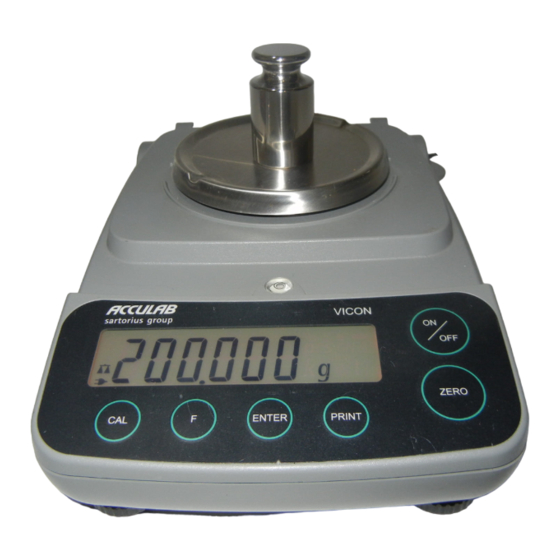
Table des Matières
Publicité
Les langues disponibles
Les langues disponibles
Liens rapides
Operating Instructions | Betriebsanleitung | Mode d'emploi |
Istruzioni per l'uso | Manual de instrucciones
ACCULAB VICON
Electronic Precision Scales/Balances | Elektronische Präzisionswaagen | Balances électroniques d'analyse et de précision |
Bilance elettroniche di precisione | Balanzas electrónicas de precisión
98648-013-61
Publicité
Chapitres
Table des Matières

Sommaire des Matières pour Acculab VICON VIC-303
- Page 1 Operating Instructions | Betriebsanleitung | Mode d’emploi | Istruzioni per l’uso | Manual de instrucciones ACCULAB VICON Electronic Precision Scales/Balances | Elektronische Präzisionswaagen | Balances électroniques d’analyse et de précision | Bilance elettroniche di precisione | Balanzas electrónicas de precisión...
- Page 32 45 Caractéristiques techniques Installation 46 Accessoires (options) – Veuillez utiliser les accessoires et options d’origine Acculab ; 46 Marque C ils ont été adaptés de façon optimale à la balance. – N’ouvrez pas la balance ! Si vous endommagez la bande...
-
Page 33: Mise En Service
Mise en service Contenu de la livraison Installation – balance avec housse de protection transparente Lors de l’installation, choisir un emplacement adéquat – plateau de pesée afin de ne pas exposer la balance aux influences externes – bloc d’alimentation suivantes : –... -
Page 34: Raccordement Au Secteur
VIC-303, VIC-123, VIC-4MG, VIC-123, VIC-4MG, VIC-2MG) VIC-2MG) N’utilisez que des blocs d’alimenta- tion – d’origine Acculab pour l’Europe : 6971948 § Insérez la fiche coudée dans la balance. $ La pile ou l’accumulateur ne font pas partie de la livraison. -
Page 35: Fonctionnement
Fonctionnement Pesée simple Description des touches Caractéristiques – Tarer la balance. Le tarage peut avoir lieu à l’intérieur de l’étendue de pesée tout entière de la balance. Opérations préliminaires § Mettre la balance en marche : appuyer sur la touche (ON/OFF). (ON/OFF) Marche/Arrêt : met la balance sous tension, §... -
Page 36: Programmes D'application
Programmes d’application Commutation d’unités Grâce à ce programme d’application, il est possible d’afficher une valeur de pesée dans une unité sélectionnée (voir tableau) et en grammes. Exemple : commuter de l’unité Livres [lb] (application) à Grammes [g] (unité de base) Etape Appuyer sur la touche Affichage... -
Page 37: Comptage
Comptage Fonction Ce programme d’application permet de déterminer le nombre de pièces ayant pratiquement le même poids. Exemple : Calcul d’un nombre de pièces inconnu en pesant le nombre de pièces de référence prédéfini (nombre de pièces de référence 20). Etape Appuyer sur la touche Affichage... -
Page 38: Pesée En Pourcentage
Pesée en pourcentage Fonction Ce programme d’application permet de déterminer le pourcentage d’un échantillon par rapport à un poids de référence. Exemple : Mesurer la valeur en pourcentage par rapport à un poids de référence mémorisé, pourcentage de référence 100 %. Etape Appuyer sur la touche Affichage... -
Page 39: Affichage Statique
Affichage statique Fonction Afficher la dernière valeur avec stabilité pendant 5 secondes (après décharge). Exemple : déterminer une valeur de pesée dans un environnement extrêmement instable Etape Appuyer sur la touche Affichage 1. Changer de programme d’application (ZERO) longuement 2. Sélectionner l’affichage statique plusieurs fois (F) 3. -
Page 40: Totalisation
Totalisation Fonction : Grâce à ce programme d’application, il est possible de totaliser des valeurs de pesée dans une mémoire. Exemple : totaliser des valeurs de pesée Etape Appuyer sur la touche Affichage 1. Changer de programme d’application (ZERO) longuement 2. -
Page 41: Poids Spécifique
Poids spécifique Fonction : Grâce à ce programme d’application, il est possible de déterminer le poids spécifique d’un échantillon. Le résultat est tou- jours affiché avec une décimale. Installation : poser un récipient en verre sous la balance. Accrocher une corbeille immergée dans de l’eau au crochet de pesée en dessous du socle (pas livrée avec la balance). -
Page 42: Ajustage
Ajustage Ajuster la balance sur son lieu d’installation. Caractéristiques Le poids nécessaire à l’ajustage s’affiche. Le processus d’ajustage ne peut être démarré que lorsque Poids d’ajustage standard sur les modèles sélectionnés : – la balance est déchargée, voir page 19. –... -
Page 43: Réglages (Menu)
Réglages (menu) La configuration de la balance peut être adaptée aux exigences de l’utilisateur. Etape Appuyer sur la touche Affichage 1. Mettre la balance hors service (ON/OFF) 2. Mettre la balance sous tension et (ON/OFF) pendant l’affichage de tous les segments (ZERO) brièvement Fonction des touches dans le menu setup : Touche... -
Page 44: Messages D'erreur
«Caractéristiques techniques» (ON/OFF) Le résultat de pesée La balance n’est pas ajustée Ajuster est manifestement faux La balance n’a pas été tarée avant la pesée Tarer Si d’autres erreurs survenaient, veuillez contacter le service après-vente Acculab ! -
Page 45: Données Techniques De L'appareil
Données techniques de l’appareil Caractéristiques techniques Modèle VIC-303 VIC-123 VIC-4MG VIC-2MG VIC-612 VIC-412 VIC-212 Etendue de pesée Précision de lecture 0,001 0,001 0,005 0,005 0,01 0,01 0,01 Etendue de tarage (soustractive) ≤±g 0,004 Ecart de linéarité 0,003 0,01 0,01 0,03 0,03 0,035 Gamme de température... -
Page 46: Accessoires (Options)
Partie 1 : Prescriptions générales modifications et tout raccordement de câbles ou d’appareils non livrés par Acculab. C’est à lui de vérifier et, si nécessaire, En cas d’utilisation de matériel électrique dans des installations de corriger ces modifications. Sur simple demande, Acculab met et des conditions d’environnement exigeant des mesures de...
